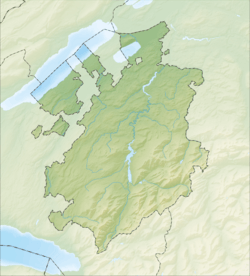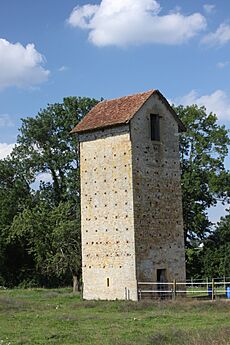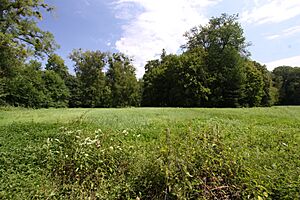Greng facts for kids
Quick facts for kids
Greng
|
||
|---|---|---|
|
||
| Country | Switzerland | |
| Canton | Fribourg | |
| District | See | |
| Area | ||
| • Total | 0.96 km2 (0.37 sq mi) | |
| Elevation | 439 m (1,440 ft) | |
| Population
(Dec 2020 )
|
||
| • Total | 178 | |
| • Density | 185.4/km2 (480/sq mi) | |
| Postal code |
3280
|
|
| Surrounded by | Courgevaux, Faoug (VD), Haut-Vully, Meyriez, Mur (VD), Murten/Morat | |
Greng is a small town, also called a municipality, located in the canton of Fribourg in Switzerland. It is part of the See/Lac district.
Contents
A Look at Greng's Past
Greng was first mentioned in official records way back in 1349. At that time, its name was written as Groyn.
Greng's Location and Land Use
Greng covers an area of about 1 square kilometer (0.39 square miles). Most of this land, about 76%, is used for farming. Forests cover about 10% of the area. The remaining 14% is built-up with buildings and roads. A very small part, about 3%, is unproductive land.
Most of the built-up areas are homes and other buildings. Roads and other ways to travel make up a smaller part. In the forests, some areas are dense with trees, while others have smaller groups of trees or orchards. The farmland is mostly used for growing crops, with some areas set aside for pastures where animals can graze.
Greng is located on the eastern shore of Lake Morat. It is about 2 kilometers (1.2 miles) southwest of the town of Murten/Morat. The municipality includes two small villages, known as hamlets: Greng-dessus and Greng-dessous.
Greng's Coat of Arms
The official coat of arms for Greng shows a black mill-wheel on a gold background. This design is called Or a Mill-wheel Sable in heraldry terms.
Who Lives in Greng? (Demographics)
Greng has a population of about 170 people. A small part of the population, around 13%, are people from other countries. Over the last ten years, the number of people living in Greng has grown a little. More people have moved into Greng than have moved away.
Most people in Greng, about 92%, speak German as their main language. A smaller group, about 5%, speak French. A very small number speak Italian.
In Greng, there are slightly more men than women. About 46% of the population are women, and 53% are men. Most people living in Greng were born in Switzerland. About 15% were born right in Greng, and 14% were born in the same canton (Fribourg). A larger group, 60%, were born in other parts of Switzerland. About 9% were born outside of Switzerland.
Young people, from babies to teenagers (0-19 years old), make up about 25% of Greng's population. Adults (20-64 years old) are the largest group, making up about 67%. Seniors (over 64 years old) make up about 9%.
Most households in Greng have about 2 to 3 people living in them. There are some households with just one person, and a few with five or more people. Most of the apartments in Greng are lived in all year round.
The chart below shows how Greng's population has changed over many years:

Important Historical Sites in Greng
Greng is home to two important historical sites. These are the archeological site at Greng-Spitz and the Turmspeicher, which is an old storage tower. Both are recognized as important heritage sites in Switzerland.
Greng-Spitz: A World Heritage Site
The Spitz area in Greng is famous for its ancient pile-dwelling settlements. These are also known as stilt houses because they were built on stilts over water or wet ground. These settlements are part of the Prehistoric Pile dwellings around the Alps which is a UNESCO World Heritage Site. This means they are very important historical places recognized by the United Nations.
People have been studying the Greng-Spitz site since the 1800s. It seems that people lived there at least three different times in history. All these ancient villages were built on a piece of land that sticks out into Lake Morat. Before the lake's water levels were controlled in the 1800s, this piece of land would often become an island when the water was high.
The oldest settlement found here was from the middle Neolithic period (New Stone Age). It was built by people of the Cortaillod culture. Scientists have studied the wood from this settlement and found it dates back to around 3864-3820 BC. A second settlement was from the end of the Neolithic period. The most recent ancient village was from the Bronze Age. Wood from this site dates to about 1058 to 954 BC. Many of the cool things found at Greng-Spitz are now on display at the Museum in Murten/Morat.
Greng's Economy and Jobs
In 2010, Greng had a low unemployment rate of 1.9%. This means most people who wanted to work had a job.
In 2008, about 20 people worked in the primary economic sector. This sector includes jobs like farming. No one worked in the secondary sector, which would be manufacturing or construction. The largest number of people, 54, worked in the tertiary sector. This sector includes jobs that provide services, like shops or offices.
Many people who live in Greng travel to other towns for work. About 65 people leave Greng to work elsewhere, while only 15 people come into Greng for their jobs. This means Greng is a "net exporter" of workers. Most people, about 61%, use a private car to get to work, while a smaller number, about 6.5%, use public transportation.
Religion in Greng
Based on information from 2000, about 24% of the people in Greng were Roman Catholic. A larger group, about 53%, belonged to the Swiss Reformed Church. Some people belonged to other churches, and about 21% said they did not belong to any church.
Education in Greng
Many adults in Greng have a good education. About 35% have finished high school (upper secondary education). Even more, about 31%, have gone on to higher education, like a university or a specialized college.
In the Canton of Fribourg, where Greng is located, children usually start with one year of optional Kindergarten. After that, they go to six years of Primary school. Then comes three years of mandatory lower Secondary school, where students are grouped by their abilities. After lower Secondary, students can choose to go to an optional upper Secondary school for three or four years. This can be a gymnasium (which prepares them for university) or a vocational program (which teaches job skills). After upper Secondary, students can go to a higher education school or start an apprenticeship.
In the 2010-2011 school year, no students actually attended school within Greng itself. However, 20 students from Greng went to schools in other towns. These included students in kindergarten, primary school, mandatory secondary school, and upper secondary school.
See also
 In Spanish: Greng para niños
In Spanish: Greng para niños






